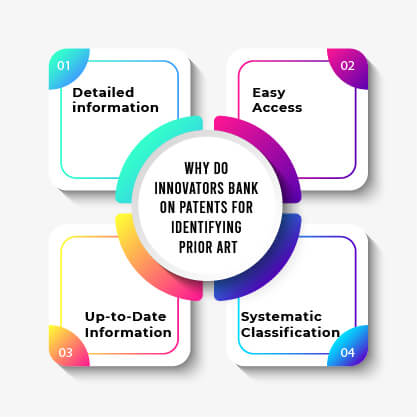Prior Art Search: What Every Innovator Needs to Know
In the fast-paced and competitive world of new ideas, getting a patent is crucial to safeguard your unique creations. However, applying for a patent without doing a detailed search for existing similar ideas can cause unexpected problems, like rejection or legal issues. A thorough search for existing ideas makes sure your invention is truly new and qualifies for a patent. This article delves deeply into the concept of prior art, its significance, and the process of conducting an effective prior art search.
Table of Contents
What is Prior Art?
Simply put, prior art refers to any information—scientific, technical information that exists before the invention in question. It’s the body of knowledge available to the public before you make your invention, and it can take many forms, including:
- Journal articles
- Technical publications
- Press releases
- Marketing brochures
- Product information sheets
- Newspaper articles
- Books and periodicals
- Existing patents
In essence, prior art includes anything that might potentially reveal your idea or make it seem unpatentable. Understanding the scope and nature of prior art is the first step in determining the uniqueness of your invention.
Why Should Innovators Care About Prior Art?
Before you apply for a patent, it’s very important to check if your invention meets the basic requirements: it must be new, useful, and not obvious. While all three are important, being new is the most crucial because it means your invention hasn’t been shown or shared with the public before.
1. Assessing Patentability
One of the main purposes of a prior art search is to check if an invention can be patented. For your invention to qualify for a patent, it must be new, meaning it hasn’t been shared with the public before. A detailed prior art search helps find out if there are any similar inventions or ideas already out there, making sure your invention is truly original.
2. Avoiding Expensive Mistakes
Applying for a patent requires a lot of time and money. If someone discovers older inventions or similar ideas that prove your invention isn’t unique, especially later in the process, your patent could be denied or canceled. Conducting a search for existing ideas early helps you avoid these costly issues and saves both time and money.
3. Strategic Decision-Making
By examining current technology and market trends through prior art searches, you can gather helpful insights. These insights can guide inventors in enhancing their ideas, adjusting their strategies, or discovering new opportunities based on what’s already out there. For instance, you might discover that your invention is similar to existing patents, which could allow you to improve it and make it more attractive to the market.
4. Improving Patent Applications
If an invention is thoroughly researched and takes into account similar existing ideas in its application, it has a higher chance of being approved. When an application recognizes and deals with similar existing ideas, it demonstrates a deep understanding of the technology area and reduces the risk of rejection. This makes your patent application more trustworthy and persuasive.
5. Avoiding Infringement Risks
A thorough search of existing inventions not only checks if your idea is new but also makes sure it doesn’t copy someone else’s patented work. Copying a patent can result in expensive legal battles, fines, and harm to your reputation. Finding similar inventions beforehand helps you avoid accidentally copying someone else’s work, protecting your invention from legal problems.
Also Read: 8 Best Practices to Ensure Accurate and Comprehensive Mechanical Prior Art Searches
The Importance of Patents in Prior Art Searches
When doing a prior art search, patent documents are usually the most trustworthy and helpful source of information. Here’s why:
1. Clear and detailed information
Patents are official documents that give clear and thorough descriptions of inventions. They include technical drawings, diagrams, and specific details. They are written to fully explain an invention to the public, so that people with basic knowledge in the field can understand and recreate it. This makes patents very useful for finding prior art because they offer complete information about earlier inventions, making it easier to compare them with your own idea.
2. Easy Access
In today’s digital world, finding patent documents is simple. Platforms like the United States Patent and Trademark Office (USPTO) and the World Intellectual Property Organization (WIPO) have huge collections of patent details. Inventors can quickly search these platforms to find information about existing inventions that relate to their own ideas.
3. Up-to-Date Information
Patents reflect the most current technological advancements. Unlike scientific journals, which can take months or even years to publish, patent documents are often available shortly after an invention is submitted. This means patent databases always have the newest information, giving inventors a clear picture of current technologies and trends. As a result, patent databases are always up to date and suitable to search prior arts.
4. Systematic Classification
Patent documents are classified according to their technological areas, making it easier to search for prior art related to specific fields. The International Patent Classification (IPC) system, used by patent offices globally, organizes patents based on their technical subject matter. This systematic classification makes searching for relevant prior art more efficient, saving time and effort for patent applicants.

Challenges in Conducting Prior Art Searches
While prior art searches are invaluable, they can also present challenges. Some of the common difficulties include:
- Volume of Data: The sheer number of patents, publications, and other documents available can make it overwhelming to find the most relevant prior art.
- Language Barriers: Prior art exists in multiple languages, requiring translation and interpretation to ensure nothing is overlooked.
- Technical Complexity: Understanding and comparing highly technical patents or research papers can be challenging, especially in highly specialized fields.
- Constantly Updating Databases: Patent databases are always being updated. This means new prior art can appear even after a patent application is submitted, which might change its chances of being approved.
Conclusion
Conducting a prior art search is a crucial step before you apply for a patent. It helps make sure your invention is new, eligible for a patent, and doesn’t risk infringing on someone else’s work. By carefully looking into existing patents and other related materials, you not only increase your chances of getting a patent but also make your position stronger in the market.
Additional Resources:
- Looking for Prior Art? This AI-based Tool Can Boost Your Searches
- 8 Best Practices to Ensure Accurate and Comprehensive Mechanical Prior Art Searches
At Sagacious IP, we provide detailed prior art search services to help inventors like you navigate the complexities of patent laws. Our skilled team can help you conduct thorough searches to confirm your invention’s uniqueness and safeguard its potential.
Don’t let unknown prior art block your innovation. Reach out to Sagacious IP today to find out how we can help protect the future of your invention.
- The Editorial Team
Having Queries? Contact Us Now!
"*" indicates required fields




